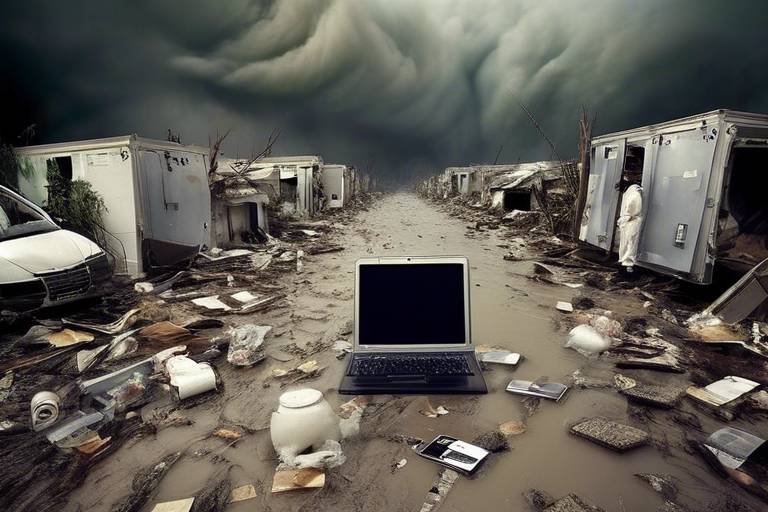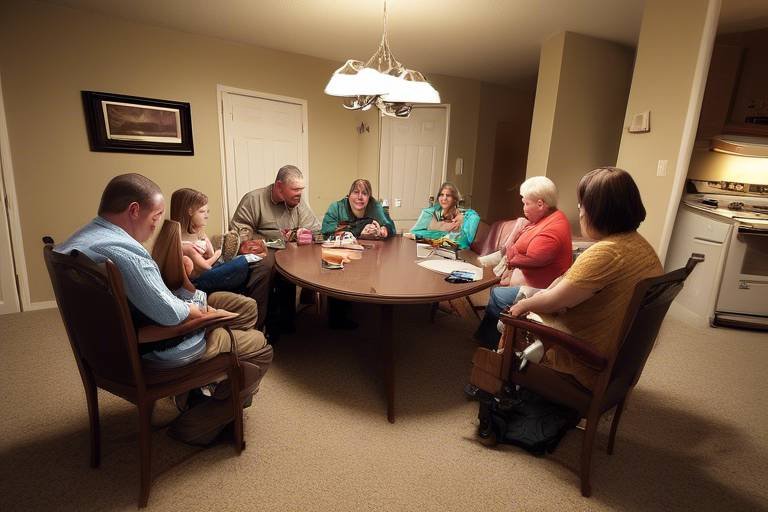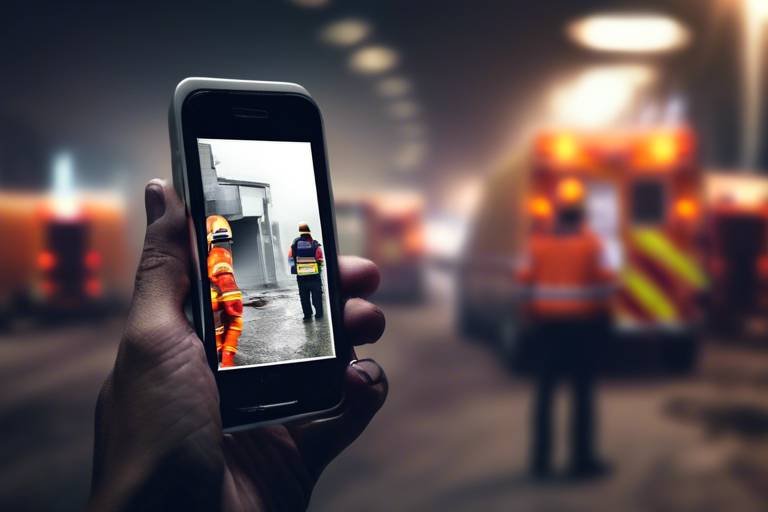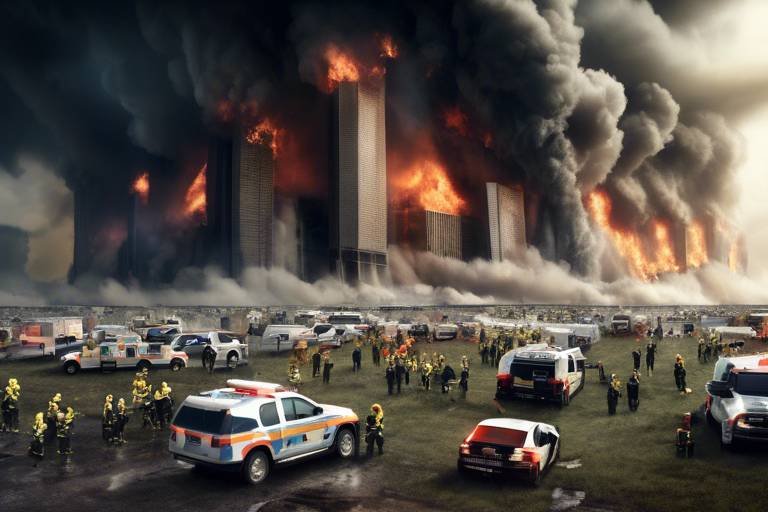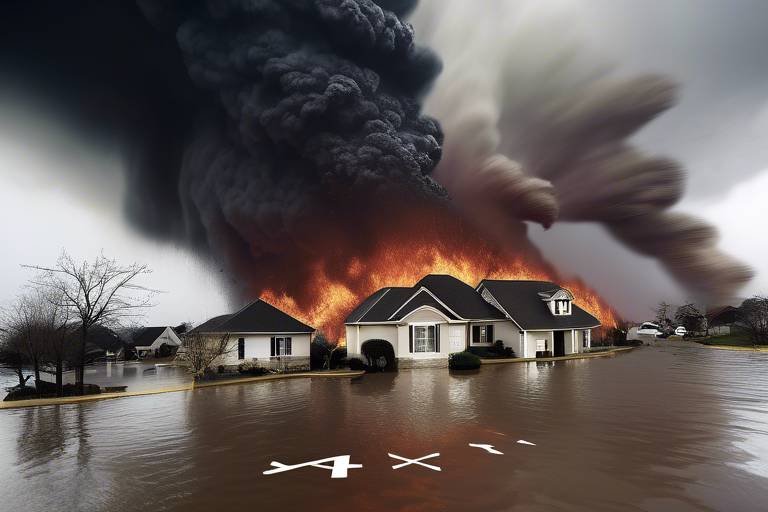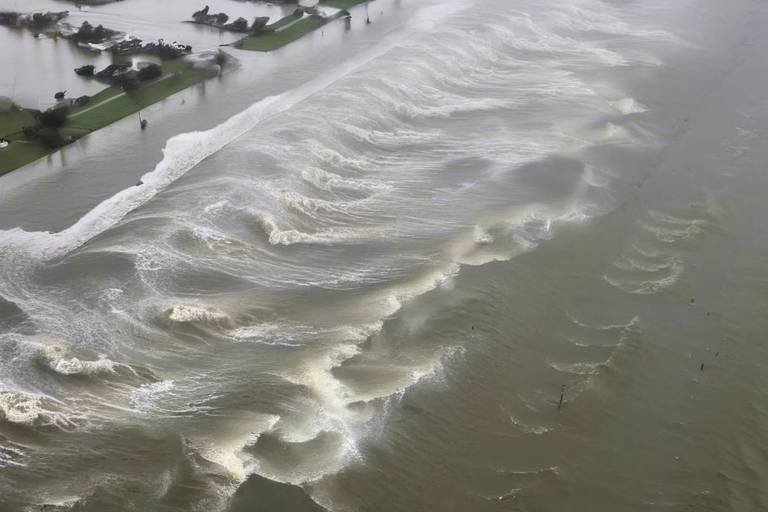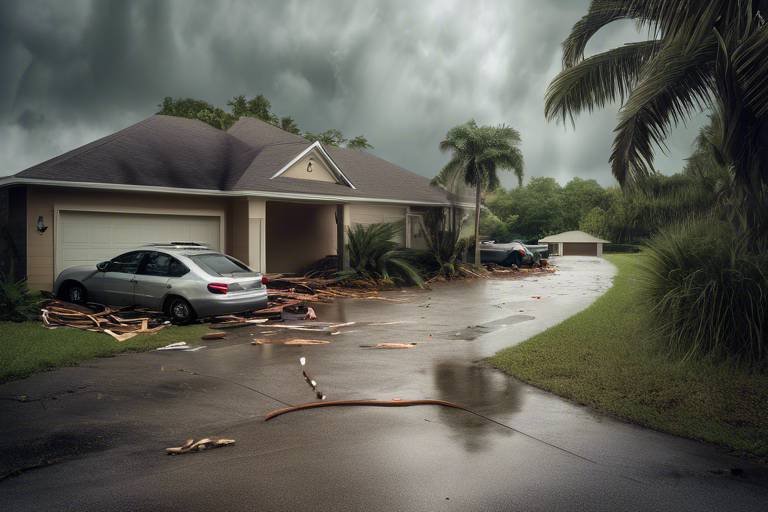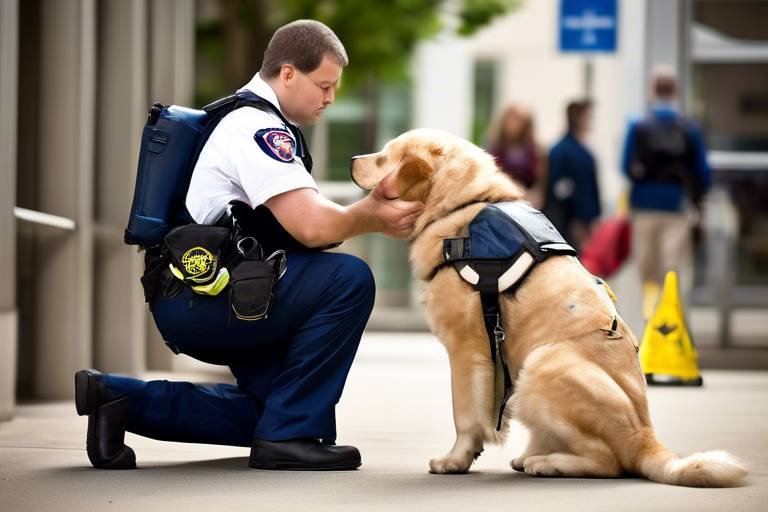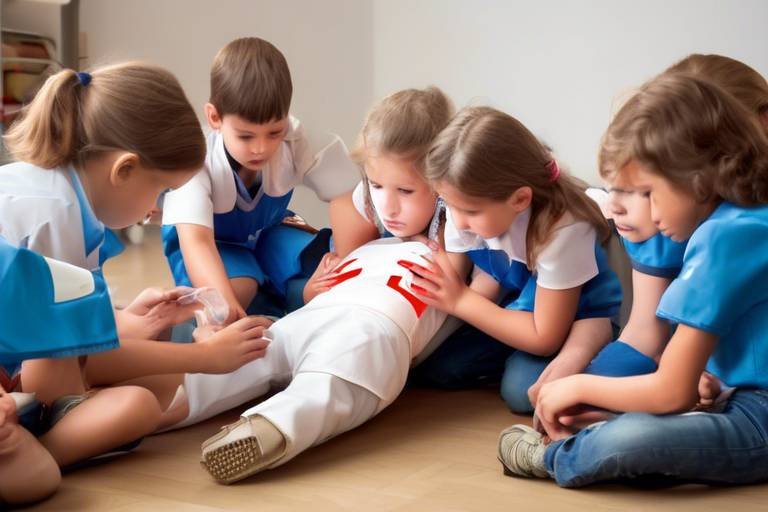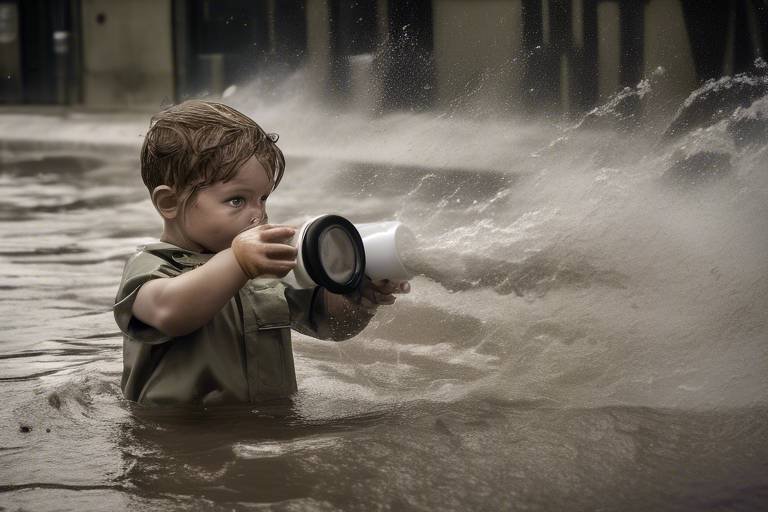Role of Internet in Disaster Response
The internet has become an indispensable tool in today's world, especially when it comes to responding to disasters. Imagine a scenario where a natural calamity strikes—be it an earthquake, hurricane, or flood. In such critical moments, the ability to communicate quickly and effectively can mean the difference between life and death. The internet serves as a lifeline, connecting responders, victims, and agencies in real-time, ensuring that vital information is disseminated swiftly and accurately. But how does it achieve this? Let's dive deeper into the multifaceted role of the internet in disaster response.
One of the most significant advantages of the internet during disasters is its capacity to facilitate real-time communication. First responders, victims, and various agencies can share crucial information almost instantaneously. Whether it's a text message, an email, or a tweet, the speed at which information travels can drastically alter the outcome of a disaster response. For instance, if a flood occurs, local agencies can quickly inform residents of evacuation routes, while responders can relay information about the most affected areas. This kind of rapid communication helps to ensure that everyone is on the same page, reducing confusion and improving the overall effectiveness of the response efforts.
The internet also enables the collection and analysis of vast amounts of data, which is essential for assessing the situation and planning appropriate responses. With the help of advanced technologies, responders can gather information from various sources, including social media, satellite imagery, and ground reports. This data can then be analyzed to identify trends, predict future developments, and allocate resources more effectively. For example, during a wildfire, data collected from drones can provide real-time updates on the fire's spread, helping teams to strategize their containment efforts.
One of the standout features of internet technologies in disaster response is the use of Geographic Information Systems (GIS). GIS tools leverage internet connectivity to offer detailed maps and spatial analysis, aiding responders in understanding the geographical context of disasters. These tools can be crucial in mapping disaster zones, where online mapping services help identify affected areas. This capability allows for better resource allocation and targeted assistance during emergencies. For instance, responders can visualize which neighborhoods are most at risk and prioritize their efforts accordingly.
Online mapping services like Google Maps or specialized GIS applications provide real-time updates on disaster zones. By integrating data from various sources, these platforms allow responders to see the extent of the damage, the locations of shelters, and the routes that are safe for travel. This information is invaluable for ensuring that aid reaches those who need it most.
Moreover, GIS technology supports the monitoring of relief operations, ensuring that aid reaches those in need efficiently. By visualizing the distribution of resources, agencies can identify gaps in service and make real-time adjustments to their strategies. This level of coordination is essential for minimizing waste and maximizing the effectiveness of relief efforts.
In addition to GIS, social media platforms have emerged as vital channels for sharing information during disasters. These platforms allow for the rapid dissemination of updates, mobilization of volunteers, and sharing of critical safety information. Imagine a scenario where a community is hit by a sudden disaster; social media can be the quickest way to spread the word about what’s happening, where to find help, and how to stay safe. Posts can go viral, reaching thousands of people in a matter of minutes, which can significantly enhance community resilience and response efforts.
The internet also fosters collaboration among various agencies, improving coordination and minimizing duplication of efforts in disaster response. In chaotic situations, multiple organizations often respond simultaneously. The internet allows these organizations to share information and resources in real-time, ensuring that everyone is working towards the same goals. Integrated response platforms can streamline communication, enhancing overall response effectiveness.
Online platforms can integrate resources and personnel from different organizations. These platforms are designed to facilitate communication and collaboration among various stakeholders, including government agencies, NGOs, and community groups. By working together, these organizations can coordinate their efforts more effectively, ensuring that resources are allocated where they are needed most.
Furthermore, the internet allows for real-time sharing of resources, such as shelters and medical supplies. This capability is essential for ensuring that responders can quickly access what they need to assist those affected by disasters. For example, if a hospital is overwhelmed, they can use online platforms to request additional medical supplies or personnel from nearby facilities, ensuring that they can continue to provide care.
Finally, the internet plays a crucial role in educating the public about disaster preparedness and response. Through various online resources, communities can equip themselves with the knowledge and skills necessary to respond effectively in emergencies. Awareness campaigns on social media and websites inform the public about safety measures and emergency procedures, helping to build a more resilient society.
Various online resources provide training for individuals and organizations, equipping them with the skills necessary for effective disaster response. Whether it’s a simple online course on first aid or a comprehensive training program for disaster management, these resources can empower communities to take action when it matters most.
Social media and websites are used for awareness campaigns, informing the public about safety measures and emergency procedures. These campaigns can be tailored to specific communities, ensuring that the information is relevant and accessible. The more informed the public is, the better prepared they will be when disaster strikes.
- How does the internet improve communication during disasters?
The internet allows for real-time communication among responders, victims, and agencies, ensuring that vital information is shared quickly and effectively. - What role do social media platforms play in disaster response?
Social media serves as a vital channel for sharing information, mobilizing volunteers, and disseminating updates during disaster situations. - How can GIS technology help in disaster response?
GIS tools provide detailed maps and spatial analysis, aiding responders in understanding the geographical context of disasters and improving resource allocation. - What resources are available for disaster preparedness education?
There are various online training programs and awareness campaigns that educate the public about disaster preparedness and response.

Enhanced Communication
The internet serves as a powerful tool for enhancing communication during disasters, acting like a lifeline that connects responders, victims, and agencies in real-time. Imagine being in a chaotic situation where every second counts; the ability to share information instantly can mean the difference between life and death. With just a few clicks, emergency responders can relay critical updates, coordinate rescue efforts, and provide instructions to those affected. This swift communication ensures that vital information is disseminated quickly and effectively, helping to save lives.
During a disaster, traditional communication methods often falter. Phone lines may be down, and radio frequencies can become congested. However, the internet transcends these barriers, enabling various platforms to facilitate communication. For instance, messaging apps, social media, and dedicated emergency response websites become invaluable resources. These platforms allow for a two-way flow of information, where not only can agencies send out alerts, but victims can also report their situations, request help, and share their locations.
Furthermore, the internet enables the use of innovative technologies such as satellite phones and mobile applications designed specifically for disaster response. These tools can function in areas with limited connectivity, ensuring that communication remains uninterrupted. For example, applications like WhatsApp and Facebook Messenger allow users to share their exact locations, send photos, and communicate with loved ones, providing a sense of security amidst chaos.
Additionally, the internet fosters collaboration among various organizations involved in disaster response. Agencies can share real-time data, such as the number of available shelters, medical supplies, and personnel. This resource-sharing capability is further enhanced by online platforms that can integrate information from multiple sources. For instance, organizations can utilize a centralized dashboard to monitor ongoing rescue operations, track resource allocation, and identify areas where assistance is urgently needed.
In summary, enhanced communication through the internet not only streamlines the flow of information but also empowers individuals and agencies to respond more effectively during disasters. By leveraging technology, we can create a more connected and resilient response network that ultimately saves lives and reduces the impact of disasters.

Data Collection and Analysis
The role of the internet in during disasters cannot be overstated. When a crisis strikes, the ability to gather and analyze data quickly can be the difference between life and death. Imagine a scenario where a natural disaster occurs; the first responders need to assess the situation rapidly to deploy resources effectively. This is where internet technologies come into play, serving as a lifeline for crucial data exchange. With the internet, responders can access real-time information about the disaster's impact, the number of affected individuals, and the resources required.
Moreover, the internet facilitates the collection of vast amounts of data from various sources. This data can be anything from weather reports to social media updates, all of which can provide valuable insights into the evolving situation. For instance, during a flood, data can be collected on water levels, road conditions, and even the locations of stranded individuals. All of this information is crucial for making informed decisions and planning appropriate responses.
One of the most powerful tools in disaster response is Geographic Information Systems (GIS). These systems leverage internet connectivity to provide detailed maps and spatial analysis that are essential for understanding the geographical context of disasters. Think of GIS as a digital compass that helps responders navigate through chaos. By visualizing data on a map, agencies can identify high-risk areas, track the movement of disaster fronts, and plan evacuation routes efficiently.
Online mapping services, powered by GIS, play a pivotal role in identifying affected areas. They allow responders to visualize the disaster's impact in real-time, enabling better resource allocation and targeted assistance. For example, a map can show which neighborhoods are flooded and which are still accessible, guiding responders to where help is most urgently needed. This capability not only enhances the efficiency of the response but also minimizes the risk to responders themselves.
GIS technology also supports the monitoring of relief operations. By using GIS tools, agencies can track where aid is being distributed and identify gaps in service delivery. This ensures that resources are allocated where they are needed most, making the relief efforts not only more effective but also more transparent. Imagine a scenario where a central command can see on a digital map where food supplies are running low, allowing them to redirect resources before a crisis escalates.
In conclusion, the integration of internet technologies in data collection and analysis during disasters significantly enhances the overall response efforts. By leveraging tools like GIS, responders can gain a comprehensive understanding of the situation, allowing them to make informed decisions quickly. The internet not only facilitates the flow of information but also empowers agencies to work collaboratively, ensuring that help reaches those in need as swiftly as possible.
- How does the internet improve disaster response? The internet enhances communication, coordination, and resource management, allowing for quicker and more effective responses.
- What is GIS and how is it used in disaster response? GIS stands for Geographic Information Systems, which provide detailed maps and spatial analysis to aid responders in understanding disaster contexts.
- Can social media help during disasters? Yes, social media serves as a vital channel for real-time updates, mobilizing volunteers, and sharing critical information with the public.

Geographic Information Systems (GIS)
Geographic Information Systems, or GIS, have revolutionized the way we approach disaster response. Imagine being able to visualize the chaos of a disaster zone in real-time, pinpointing exactly where aid is needed most. This technology, powered by the internet, allows responders to create detailed maps that illustrate the extent of the damage and the locations of affected populations. With GIS, data is not just numbers and figures; it transforms into a vivid picture that helps emergency services make informed decisions.
One of the most significant advantages of GIS is its ability to integrate various data sources. For instance, during a natural disaster, responders can overlay different types of information, such as population density, infrastructure status, and environmental hazards. This multi-layered approach enables a comprehensive understanding of the situation. For example, a GIS map might show areas with high population density that are also near damaged roads, indicating where immediate assistance is crucial.
Moreover, GIS technology is instrumental in mapping disaster zones. By utilizing online mapping services, emergency responders can quickly identify the most severely affected areas. This is not just about knowing where the disaster struck; it’s about understanding the geographical context. For instance, is a community cut off by floodwaters? Are there nearby hospitals that can accommodate the influx of patients? Such insights are invaluable for effective resource allocation, ensuring that help reaches those who need it most.
In addition to mapping, GIS plays a critical role in tracking relief efforts. By employing real-time data feeds, agencies can monitor the distribution of resources like food, water, and medical supplies. This ensures that aid is not only dispatched but also reaches the right places at the right times. Imagine a scenario where a shipment of supplies is on its way, but due to unforeseen road closures, it cannot reach its destination. With GIS, responders can quickly reroute the shipment, optimizing the delivery process and minimizing delays.
As we look towards the future, the integration of GIS with other internet technologies holds immense potential for enhancing disaster response. For example, combining GIS with social media data can provide real-time insights into public needs and sentiments. This synergy can lead to more effective communication strategies and a better understanding of how communities are coping during crises.
In summary, Geographic Information Systems are not just tools; they are lifelines in the chaotic aftermath of disasters. By providing critical data visualization and analysis, GIS enables responders to act swiftly and effectively, ensuring that help is not just a promise but a reality for those in need.
- What is GIS? GIS stands for Geographic Information Systems, which are used to capture, store, analyze, and manage spatial and geographic data.
- How does GIS help in disaster response? GIS helps responders visualize disaster areas, analyze data for better decision-making, and track the distribution of resources in real-time.
- Can GIS be used in non-disaster situations? Yes, GIS is widely used in urban planning, environmental monitoring, resource management, and many other fields beyond disaster response.
- What types of data can be integrated into GIS? GIS can integrate various data types, including satellite imagery, demographic information, infrastructure details, and environmental data.

Mapping Disaster Zones
When disaster strikes, the chaos can be overwhelming. Imagine a hurricane tearing through a city, leaving destruction in its wake. In such moments, knowing where to go, where the danger lies, and how to navigate through the debris is crucial. This is where online mapping services come into play, acting like a lifeline for both responders and victims. By utilizing these digital maps, emergency services can pinpoint the most affected areas and allocate resources more effectively. It’s like having a treasure map in a world of uncertainty, guiding aid workers to where they are needed most.
Online mapping tools provide a visual representation of disaster zones, allowing responders to see not just the extent of the damage but also the geographical features that could complicate rescue efforts. For instance, a flood might wash out bridges, making certain routes impassable. With detailed maps at their disposal, responders can quickly adjust their plans, rerouting teams and supplies to ensure that help reaches those stranded as swiftly as possible. The ability to visualize data in real-time is akin to having a bird’s-eye view of the situation, enabling strategic decisions that save lives.
Moreover, these mapping services can be integrated with other technologies, like Geographic Information Systems (GIS), to provide even deeper insights. For example, by layering data such as population density, infrastructure status, and available resources, responders can create a comprehensive picture of the disaster landscape. This integration allows for targeted assistance, ensuring that the most vulnerable populations receive help first. It’s a bit like playing a game of chess, where every move is calculated based on the current state of the board.
Furthermore, online maps can also serve as vital tools for the public. During a disaster, individuals can access these maps to find safe routes, locate shelters, and understand the risks in their immediate vicinity. This accessibility empowers citizens to make informed decisions, reducing panic and confusion. For instance, if a wildfire is threatening a neighborhood, residents can quickly check the map for evacuation routes and updates on the fire’s progression. In this way, online mapping is not just a tool for responders but a resource for the community at large.
In summary, mapping disaster zones through online services is an essential component of effective disaster response. It enhances situational awareness, facilitates resource allocation, and empowers both responders and the public. As technology continues to evolve, the potential for even more sophisticated mapping solutions will only increase, paving the way for quicker and more efficient disaster management strategies.
- How do online maps help during a disaster? Online maps provide real-time information about affected areas, helping responders and the public navigate safely and efficiently.
- Can anyone access these mapping services? Yes, many online mapping services are available to the public, allowing individuals to stay informed during emergencies.
- What technology is used in mapping disaster zones? Geographic Information Systems (GIS) and various online mapping platforms are commonly used to visualize and analyze disaster data.

Tracking Relief Efforts
In the chaotic aftermath of a disaster, keeping track of relief efforts can feel like trying to find a needle in a haystack. However, with the power of the internet, this daunting task becomes much more manageable. Real-time tracking of relief operations is essential to ensure that aid reaches those who need it most, and various online tools and platforms have emerged to facilitate this process.
One of the most significant advancements in tracking relief efforts is the use of Geographic Information Systems (GIS). These systems not only provide detailed maps of affected areas but also allow responders to visualize the distribution of resources and aid workers. Imagine being able to see a live map where every shelter, medical station, and distribution center is located. This capability enables organizations to make informed decisions about where to allocate resources, thereby maximizing the impact of their efforts.
Moreover, social media platforms play a crucial role in tracking relief efforts. Organizations and volunteers can post updates about what is needed in specific areas, creating a dynamic flow of information. For example, a local NGO might tweet that they are short on medical supplies in a particular region, prompting other organizations to respond quickly. This kind of communication is invaluable in a crisis, as it fosters collaboration and ensures that no one is left in the dark.
Additionally, **mobile applications** are increasingly being utilized to track relief efforts. These apps allow volunteers and responders to report their locations, share updates on the status of relief operations, and even request assistance when needed. The immediacy of mobile technology means that information can be disseminated almost instantly, which is critical during emergencies when every second counts.
To illustrate the effectiveness of these tracking methods, consider the following table that outlines different tools used in tracking relief efforts:
| Tool | Description | Benefits |
|---|---|---|
| GIS Mapping | Visual representation of disaster areas and resources. | Improves resource allocation and situational awareness. |
| Social Media | Platforms for real-time updates and community engagement. | Enhances communication and mobilizes volunteers. |
| Mobile Apps | Applications for reporting and coordination among responders. | Facilitates immediate reporting and resource requests. |
In conclusion, tracking relief efforts through the internet is a game changer in disaster response. By leveraging advanced technologies like GIS, social media, and mobile applications, organizations can ensure that aid is delivered efficiently and effectively. As we continue to innovate in the realm of disaster management, the role of the internet will only become more critical, helping us to save lives and rebuild communities in the wake of devastation.
- How does GIS technology help in disaster relief?
GIS technology provides detailed maps and spatial analysis, allowing responders to visualize affected areas and allocate resources effectively. - What role does social media play during disasters?
Social media serves as a vital communication channel for sharing information, mobilizing volunteers, and providing updates during emergencies. - Are there specific mobile apps for disaster response?
Yes, various mobile applications are designed for tracking relief efforts, reporting needs, and coordinating among responders.

Social Media Impact
In today's digital age, social media has become a powerhouse for communication, especially during disaster situations. Imagine a world where information flows like a river, connecting people in real-time, regardless of their location. Social media platforms such as Twitter, Facebook, and Instagram serve as vital channels for sharing information, mobilizing volunteers, and disseminating updates during disasters. When a hurricane hits or an earthquake shakes a community, the first instinct of many is to reach for their smartphones and share what they know. This instinct is not just a personal reaction; it's a critical part of how we respond to crises.
One of the most remarkable aspects of social media during disasters is its ability to spread information rapidly. For instance, a single tweet can reach thousands of people within seconds, providing crucial updates about evacuation routes, safety guidelines, and available resources. This immediacy can be a lifesaver. In fact, studies have shown that information shared on social media can significantly reduce panic and confusion among the affected populations. When people know where to go for help or how to stay safe, they are more likely to take appropriate action.
Moreover, social media platforms are not just tools for information dissemination; they also facilitate community engagement. People often turn to these platforms to offer assistance, whether it's providing shelter, sharing food supplies, or volunteering for relief efforts. For example, during the devastating wildfires in California, local residents utilized Facebook groups to coordinate efforts, share resources, and keep each other informed about the evolving situation. This sense of community can transform a chaotic situation into a more organized response, allowing individuals to come together and support one another.
However, the impact of social media is not solely positive. Misinformation can spread just as quickly as accurate information, leading to confusion and potentially dangerous situations. It’s crucial for individuals and organizations to verify the information before sharing it. To combat misinformation, many agencies and organizations have taken proactive steps by using their official social media channels to provide verified updates and guidelines. This helps to establish a reliable source of information amidst the noise of social media chatter.
In conclusion, the impact of social media in disaster response is profound and multifaceted. It enhances communication, fosters community engagement, and can even save lives. As we continue to navigate through emergencies, harnessing the power of social media effectively will be essential for improving disaster response strategies. The next time a disaster strikes, remember that your smartphone can be more than just a communication device; it can be a lifeline for yourself and others in need.
- How does social media help during disasters?
Social media helps by providing real-time information, facilitating community engagement, and mobilizing resources quickly. - What are the risks of using social media in disaster response?
Misinformation can spread rapidly on social media, which can lead to confusion and panic among affected populations. - How can I verify information shared on social media during a disaster?
Always check official sources, such as government agencies or reputable news outlets, before acting on information from social media.

Coordination Among Agencies
This article explores the critical role the internet plays in disaster response, highlighting its impact on communication, coordination, and resource management during emergencies.
The internet facilitates real-time communication among responders, victims, and agencies, ensuring that vital information is shared quickly and effectively during disasters.
Internet technologies enable the collection and analysis of vast amounts of data, which can be crucial for assessing the situation and planning appropriate responses.
GIS tools leverage internet connectivity to provide detailed maps and spatial analysis, aiding responders in understanding the geographical context of disasters.
Online mapping services help identify affected areas, allowing for better resource allocation and targeted assistance during emergencies.
GIS technology supports the monitoring of relief operations, ensuring that aid reaches those in need efficiently.
Social media platforms serve as vital channels for sharing information, mobilizing volunteers, and disseminating updates during disaster situations.
In the chaotic aftermath of a disaster, coordination among various agencies becomes not just important, but essential. The internet acts as a glue that binds these organizations together, facilitating seamless communication and collaboration. Imagine a massive puzzle where every piece represents a different agency—without a clear picture of how they fit together, you end up with a jumbled mess. However, with the internet, agencies can share information in real time, enabling them to align their efforts and strategies effectively.
One of the most significant advantages of internet-facilitated coordination is the ability to create integrated response platforms. These platforms serve as centralized hubs where different organizations can share resources, personnel, and information. For example, during a natural disaster, agencies can quickly update their status on the platform, letting others know what resources they have available and what they still need. This not only improves efficiency but also minimizes the duplication of efforts, ensuring that aid reaches those who need it most without unnecessary delays.
Moreover, the internet allows for real-time resource sharing. Consider a scenario where multiple shelters are set up in response to a hurricane. Agencies can use online tools to track the availability of beds, medical supplies, and food. This level of transparency ensures that responders can quickly access what they need, reducing the time spent on logistics and allowing them to focus on what truly matters—helping affected communities.
In conclusion, the internet is not merely a tool; it is a lifeline that enhances coordination among various agencies during disaster response. The ability to communicate effectively, share resources, and collaborate seamlessly can make all the difference in saving lives and restoring communities.
The internet plays a crucial role in educating the public about disaster preparedness and response, helping communities become more resilient.
Various online resources provide training for individuals and organizations, equipping them with the skills necessary for effective disaster response.
Social media and websites are used for awareness campaigns, informing the public about safety measures and emergency procedures.
- How does the internet improve disaster response?
The internet enhances communication, coordination, and resource management, allowing agencies to work together more effectively. - What role do social media platforms play in emergencies?
Social media serves as a channel for real-time updates, mobilizing volunteers, and sharing critical information during disasters. - What are integrated response platforms?
These are centralized online systems that allow different organizations to share resources and information during a disaster. - How can I prepare for a disaster using online resources?
Many websites offer training programs and awareness campaigns to educate the public on disaster preparedness and response strategies.

Integrated Response Platforms
In the chaotic aftermath of a disaster, the ability to coordinate efforts effectively can mean the difference between life and death. This is where come into play. These online systems are designed to bring together various organizations, agencies, and volunteers into a cohesive unit, ensuring that everyone is on the same page. Imagine a well-oiled machine where each part communicates seamlessly with the others—this is the essence of integrated response platforms during emergencies.
One of the most significant advantages of these platforms is their ability to streamline communication. When disaster strikes, time is of the essence. Integrated response platforms allow for real-time updates and information sharing, enabling responders to make informed decisions quickly. For instance, if a new shelter opens up, or if a particular area is deemed unsafe, these updates can be communicated instantly to all relevant parties. This not only enhances the efficiency of the response but also minimizes the risk of duplicated efforts.
Furthermore, these platforms often feature a centralized database that tracks resources, personnel, and ongoing operations. This means that organizations can easily see what supplies are available, where volunteers are needed, and which areas still require assistance. By having this information at their fingertips, responders can allocate resources more effectively. For example, if one organization has an excess of medical supplies while another is running low, they can quickly coordinate to redistribute those supplies where they are most needed.
To illustrate the effectiveness of integrated response platforms, consider the following table that highlights key features and their impacts:
| Feature | Impact |
|---|---|
| Real-time Communication | Ensures timely updates and rapid decision-making |
| Centralized Resource Database | Improves resource allocation and minimizes waste |
| Volunteer Coordination | Maximizes manpower and efficiency in response efforts |
| Data Analytics | Informs strategic planning and future preparedness |
Moreover, integrated response platforms foster collaboration among diverse groups. Whether it’s local government agencies, non-profit organizations, or community volunteers, these platforms create a common ground for all stakeholders. The collective effort leads to a more robust response, as each organization can contribute its unique strengths. Think of it as a symphony where every instrument plays its part to create a harmonious outcome—this is what happens when agencies come together using integrated response platforms.
In conclusion, the role of integrated response platforms in disaster management cannot be overstated. They not only enhance communication and resource sharing but also foster collaboration among various entities. By leveraging technology in this way, we can ensure that our response to disasters is as effective and efficient as possible, ultimately saving lives and aiding recovery efforts.
- What are integrated response platforms? Integrated response platforms are online systems that facilitate communication and coordination among various organizations involved in disaster response.
- How do these platforms improve disaster response? They streamline communication, provide real-time updates, and allow for efficient resource allocation, ensuring that responders can work together effectively.
- Can anyone access these platforms? Access typically varies by platform, but many are designed to be accessible to authorized personnel from different organizations involved in disaster response.
- What technology is used in integrated response platforms? These platforms often utilize cloud computing, data analytics, and GIS technology to provide comprehensive support during emergencies.

Resource Sharing
In the chaotic aftermath of a disaster, becomes a lifeline for those affected. The internet plays a pivotal role in facilitating this sharing, ensuring that vital resources such as food, water, medical supplies, and shelter are distributed efficiently and effectively. Imagine a scenario where a community is struck by a devastating flood. Without the internet, coordinating the delivery of resources would be akin to finding a needle in a haystack. However, with online platforms, responders can quickly assess what is needed and where, allowing for a swift and organized response.
One of the most significant advantages of resource sharing through the internet is the ability to provide real-time updates. Organizations can post requests for specific items, and volunteers can offer what they have available. This dynamic exchange not only speeds up the response time but also fosters a sense of community as individuals come together to assist their neighbors in need. For instance, during the recent wildfires in California, various online platforms enabled residents and local organizations to share information about available shelters, food distribution points, and medical assistance, drastically improving the situation on the ground.
Furthermore, the internet allows for the creation of databases that track available resources. These databases can include everything from the locations of emergency shelters to the stock of medical supplies in local hospitals. By centralizing this information, responders can make informed decisions about where to allocate resources most effectively. For example, a table could be set up to display the availability of critical supplies:
| Resource Type | Location | Available Quantity |
|---|---|---|
| Food Supplies | Community Center A | 200 meals |
| Medical Kits | Local Hospital B | 50 kits |
| Water Bottles | School C | 500 bottles |
This kind of transparent sharing of resources not only enhances the efficiency of disaster response but also builds trust among the community members and organizations involved. People are more likely to contribute when they see that their donations are making a tangible impact. Additionally, the internet enables organizations to collaborate and share resources, reducing redundancy and ensuring that aid reaches those who need it most.
In conclusion, the internet is not just a tool for communication; it is a vital component of resource sharing in disaster response. It transforms a potentially overwhelming situation into a manageable one, allowing for a coordinated effort that can save lives and restore communities. As we continue to rely on digital connectivity, it’s essential to recognize and harness the power of the internet in our collective efforts to respond to disasters.
- How does the internet improve disaster response?
The internet enhances communication, coordination, and resource sharing among responders and affected communities, leading to more efficient and effective disaster management. - What role do social media platforms play in disaster response?
Social media serves as a real-time channel for information sharing, mobilizing volunteers, and providing updates on the situation during disasters. - Can the internet help in training for disaster preparedness?
Yes, various online training programs and resources are available to equip individuals and organizations with essential skills for effective disaster response.

Public Awareness and Education
The internet is a powerful tool that plays a crucial role in enhancing public awareness and education regarding disaster preparedness and response. In a world where information travels faster than the speed of light, the ability to access and disseminate critical information can mean the difference between chaos and organized response. Imagine being able to educate millions of people about safety measures with just a few clicks! This is the magic of the internet.
Through various online platforms, communities can learn about potential risks and how to prepare for them. Websites dedicated to disaster preparedness offer guides, checklists, and interactive tools that help individuals and families create their own emergency plans. For instance, a simple online survey can help users assess their vulnerabilities and suggest tailored preparations. This level of personalization is invaluable, as it empowers people to take action based on their unique circumstances.
Moreover, social media has revolutionized the way information is shared during emergencies. During a disaster, platforms like Twitter, Facebook, and Instagram become lifelines for real-time updates. Organizations can quickly inform the public about evacuation routes, shelter locations, and safety protocols. This rapid dissemination of information not only keeps people informed but also fosters a sense of community as individuals share their experiences and support one another.
In addition to immediate communication during disasters, the internet is also a hub for ongoing education. Various online training programs are available, equipping individuals and organizations with the necessary skills for effective disaster response. These programs cover a wide range of topics, including first aid, crisis management, and emergency planning. By participating in these courses, community members can become vital assets in their neighborhoods when disaster strikes.
To illustrate the importance of public awareness, consider the following table that highlights some key online resources available for disaster preparedness:
| Resource | Description | Link |
|---|---|---|
| Ready.gov | A comprehensive guide on disaster preparedness by FEMA. | Visit |
| American Red Cross | Offers training courses and safety information. | Visit |
| CDC Emergency Preparedness | Information on public health emergencies and how to prepare. | Visit |
These resources are just the tip of the iceberg. The internet has made it easier than ever for individuals to educate themselves and their families about disaster preparedness. Awareness campaigns run on social media platforms can reach vast audiences, informing people about safety measures and emergency procedures. For example, hashtags like #DisasterPreparedness and #EmergencyReady can trend on Twitter, connecting people with vital information and encouraging community engagement.
In conclusion, the internet is not merely a tool for communication; it is a lifeline for education and awareness in the face of disasters. By leveraging online resources, communities can become more resilient, ensuring that they are not only prepared for emergencies but also capable of responding effectively when they occur. The more we educate ourselves and others, the stronger our communities will be in the face of adversity.
- How can I prepare my family for a disaster? Start by creating an emergency plan, assembling a disaster supply kit, and staying informed about local hazards.
- What online resources are best for disaster preparedness? Websites like Ready.gov and the American Red Cross offer valuable information and training.
- How can social media help during a disaster? Social media provides real-time updates and a platform for communities to share information and support each other.

Online Training Programs
In the digital age, the importance of cannot be overstated, especially when it comes to disaster response. These programs serve as a lifeline, providing individuals and organizations with the essential skills and knowledge needed to effectively respond to emergencies. Imagine a world where anyone can access critical training at the click of a button, regardless of their location. This is the power of the internet, transforming how we prepare for and respond to disasters.
Online training programs cover a wide range of topics, from basic first aid to advanced emergency management strategies. They are designed to be accessible and user-friendly, often incorporating interactive elements such as videos, quizzes, and simulations that engage learners and enhance retention. For instance, a program might include a simulation of a disaster scenario where participants must make quick decisions based on real-time data. This hands-on approach not only boosts confidence but also prepares individuals for the chaos that often accompanies real-life emergencies.
Moreover, many of these programs are tailored to specific audiences, including community leaders, healthcare professionals, and volunteers. This customization ensures that the training is relevant and practical. For example, a community leader might take a course on how to organize local disaster response efforts, while a healthcare worker might focus on triage and patient management during a crisis. The flexibility of online training allows participants to learn at their own pace, making it easier for busy professionals to fit education into their schedules.
Additionally, the collaborative nature of online training fosters a sense of community among participants. Many programs include forums or discussion groups where learners can share experiences, ask questions, and provide support to one another. This peer-to-peer interaction not only enriches the learning experience but also builds a network of informed individuals who can collaborate during actual disasters.
To illustrate the impact of online training programs, consider the following table that highlights some popular platforms offering disaster response training:
| Platform | Course Offerings | Target Audience | Accessibility |
|---|---|---|---|
| FEMA's Emergency Management Institute | Incident Command System, Community Preparedness | Emergency Managers, Community Leaders | Free, self-paced |
| Red Cross | First Aid, CPR, Disaster Preparedness | General Public, Healthcare Providers | Paid, various formats |
| Coursera | Disaster Risk Management, Crisis Leadership | Students, Professionals | Free/Paid, flexible schedule |
As we navigate the complexities of disaster response, it’s clear that online training programs are more than just educational tools; they are essential components of a resilient community. By equipping individuals with the necessary skills and knowledge, we empower them to take action when it matters most. The internet has not only changed the way we learn but has also revolutionized our approach to disaster preparedness and response.
Q: How can I find a suitable online training program for disaster response?
A: Start by researching reputable organizations such as FEMA, the Red Cross, and local emergency management agencies. Look for programs that align with your specific needs and interests.
Q: Are online training programs recognized by employers?
A: Many employers value online training, especially if it comes from accredited institutions. Be sure to check if the program offers certification upon completion.
Q: Can I access these training programs from anywhere?
A: Yes! One of the key benefits of online training is that you can access it from anywhere with an internet connection, making it convenient for all learners.

Awareness Campaigns
In the ever-evolving landscape of disaster response, awareness campaigns serve as a beacon of hope and information for communities facing the unknown. These campaigns leverage the power of the internet to disseminate crucial information about disaster preparedness, safety measures, and emergency procedures. Imagine waking up to a natural disaster; the chaos and confusion can be overwhelming. However, when communities are armed with knowledge, they can respond more effectively and save lives. Awareness campaigns play a pivotal role in transforming this knowledge into action.
Social media platforms, websites, and online forums are the modern-day megaphones, amplifying messages that can make a significant difference. For instance, consider the impact of a well-timed tweet or a Facebook post that informs the public about an impending storm or evacuation procedures. These platforms allow for rapid dissemination of information, reaching thousands in mere seconds. Not only do they provide updates, but they also encourage community engagement, inviting citizens to share their experiences and insights, which can be invaluable during a crisis.
Moreover, awareness campaigns often include interactive elements that cater to various demographics. For instance, infographics, videos, and live webinars can effectively convey complex information in a digestible format. By using visually engaging content, these campaigns make it easier for individuals to understand the steps they need to take before, during, and after a disaster. The objective is clear: to empower individuals with the knowledge and confidence to act decisively when disaster strikes.
To illustrate the impact of these campaigns, let's take a look at some key components that are commonly included:
| Component | Description |
|---|---|
| Educational Resources | Providing guides, checklists, and videos on disaster preparedness and response. |
| Community Engagement | Encouraging local participation through workshops and training sessions. |
| Real-Time Updates | Utilizing social media for immediate alerts and information sharing during emergencies. |
| Partnerships | Collaborating with local organizations to enhance outreach and effectiveness. |
In conclusion, awareness campaigns powered by the internet are essential in fostering a culture of preparedness. They not only inform but also inspire action, encouraging individuals to take charge of their safety and the safety of their loved ones. By harnessing the collective power of community engagement and technology, these campaigns can significantly enhance resilience in the face of disasters.
- What is the purpose of awareness campaigns in disaster response?
Awareness campaigns aim to educate the public about disaster preparedness, safety measures, and emergency procedures, ultimately saving lives and reducing panic during crises. - How do social media platforms contribute to these campaigns?
Social media platforms allow for rapid information dissemination, community engagement, and real-time updates, making them vital tools in disaster awareness. - What types of content are typically included in awareness campaigns?
Common content includes educational resources, infographics, videos, community workshops, and real-time updates on emergencies. - Can individuals participate in awareness campaigns?
Absolutely! Individuals can participate by sharing information, attending workshops, and engaging with their communities online to spread awareness.
Frequently Asked Questions
- How does the internet enhance communication during disasters?
The internet enables real-time communication among responders, victims, and agencies. This immediacy allows vital information to be shared quickly and effectively, which is crucial during emergencies when every second counts.
- What role do Geographic Information Systems (GIS) play in disaster response?
GIS tools leverage internet connectivity to provide detailed maps and spatial analysis. They help responders understand the geographical context of disasters, identify affected areas, and ensure that resources are allocated efficiently.
- How can social media be utilized in disaster situations?
Social media platforms are essential for sharing information, mobilizing volunteers, and disseminating updates during disasters. They serve as a quick way to reach large audiences and keep everyone informed about safety measures and ongoing relief efforts.
- What are integrated response platforms?
Integrated response platforms are online tools that bring together resources and personnel from various organizations. This collaboration streamlines communication, improves coordination, and minimizes the duplication of efforts in disaster response.
- How does the internet facilitate resource sharing during emergencies?
The internet allows for real-time sharing of resources such as shelters, medical supplies, and volunteer efforts. This ensures that responders can quickly access what they need to assist those affected by disasters.
- Why is public awareness and education important in disaster response?
Public awareness and education help communities become more resilient by informing them about disaster preparedness and response strategies. The internet plays a crucial role in disseminating this information through online training programs and awareness campaigns.
- What types of online training programs are available for disaster response?
There are various online resources that provide training for individuals and organizations, equipping them with the necessary skills for effective disaster response. These programs cover topics such as first aid, emergency management, and crisis communication.

